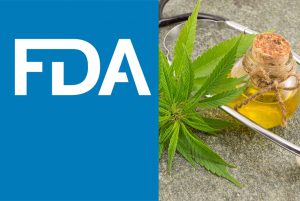
(Legal experts weigh in on what the FDA’s cannabis guidelines mean for the hemp industry.)
Federal food and drug officials dropped draft guidance for clinical research related to developing cannabis and cannabis-derived drug products.
The U.S. Food and Drug Administration’s seven-page draft guidance, titled “Cannabis and Cannabis-Derived Compounds: Quality Considerations for Clinical Research Guidance for Industry,” focuses on pharmaceutical quality and chemistry, manufacturing and controls.
The guidance, released Tuesday, doesn’t establish rules or regulations or highlight any next steps beyond asking for public comment.
Rather, the recommendations included are intended to provide clarity following “recent legislation” – the 2018 Farm Bill – and introduce key regulatory concepts that are part of the FDA drug-approval process to those who might not be familiar with them.
Cannabis research legality
The FDA guidance reiterates that under the Food, Drug and Cosmetics Act, any products marketed with therapeutic claims are therefore considered to be drugs.
If a product is not generally recognized as safe or effective among experts, then it is considered a new drug and must be approved by the FDA before it can be introduced into interstate commerce.
The agency has continued to send warning letters to companies marketing hemp-derived CBD with therapeutic claims, explaining that such pronouncements make the products new drugs and, thus, would need to go through the FDA approval process.
The FDA’s new guidance also describes the drug-development and clinical-trialing process:
- The investigational new drug (IND) application is a mechanism for drug development.
- The resulting data from the IND is used in a new drug application (NDA), which is the formal proposal for the FDA’s approval.

Shawn Hauser
“It gives needed clarity to companies developing cannabis-based drugs as to specific guidelines and standards they must follow to receive approval for new drugs – citing existing standards for clinical research specific to botanicals and other new standards unique to the cannabis plant, including those related to THC content,” Hauser said.
The guidance also highlights changes in how the 2018 Farm Bill changed the way cannabis is treated under the Controlled Substances Act (CSA).
Specifically, the Farm Bill created a new definition of hemp that “includes cannabis and derivatives or extracts of cannabis with no more than 0.3% by dry weight of the compound delta-9 tetrahydrocannabinol.”
The Farm Bill omitted the definition of “marihuana,” a move that means hemp is no longer a controlled substance.
Activities related to using cannabis in an IND for research must comply with CSA and U.S. Drug Enforcement Agency requirements if the cannabis or a derivative compound exceeds the federally legal threshold.
Cannabis sources
For years, the only domestic source of cannabis for legal clinical research purposes was the National Institute on Drug Abuse.
But the changes made by the 2018 Farm Bill now allow hemp to be used as a source for cannabis drug development, providing new options for new product sponsors, according to the guidance.
Meanwhile, NIDA remains the only source for domestic federally legal source of cannabis over the 0.3% delta-9 THC limit for clinical research.

Jonathan Havens
“There’s a footnote in the guidance that the DEA is committed to opening up additional forces, but so far that hasn’t happened,” said cannabis attorney Jonathan Havens, a Washington DC-based partner with Saul Ewing Arnstein & Lehr.
Hauser said the delay in expanding the supply of marijuana for research causes continued suffering for medical patients, who could benefit from higher THC content for effective treatment.
“The federal government continues to drag its feet on expanding the supply of federally legal marijuana for research, despite the increasing number of qualified applicants,” she added.
“This issue should be front and center until we have a supply of quality product to support legitimate research and development of cannabis-based medicines in the U.S.”
Calculating THC
The FDA guidance includes recommendations regarding the use of cannabis and derivative compounds that are both within the federally legal 0.3% THC threshold and above, including testing and analysis, among others.
Whether or not the cannabis compounds they are using meet the definition of hemp, the guidance recommends drug sponsors:
- Work with reliable laboratories for analytical testing.
- Refer to the U.S. Department of Agriculture’s interim final rule for sampling and testing methods for evaluating the level of delta-9 THC in a cannabis botanical raw material.
The document also includes important guidance relevant to other hemp-containing products – most notably how to calculate THC content in end consumer products, Hauser said.
“One glaring issue with U.S. hemp laws is that the legal standard for hemp is 0.3% THC ‘as measured on a dry-weight basis,’ with USDA rules applying this measurement to the crop and not end products,” Hauser said.
“The ‘dry-weight basis’ measurement is not generally applicable to all types of end products such as tinctures, foods, etc., and it has resulted in much confusion and frustration for businesses and regulators as well as concern by consumers.”
Hauser said standards for these measurements should be determined by federal law, clearly set forth and not left to states and businesses to decipher.
Notably, she added, the FDA is accepting public comment on suggested THC content calculations.
The guidance also provides clarity on federal hemp laws that are subject to differing interpretations, leaving businesses exposed to risk.
“For example, what happens when legal hemp spikes above 0.3% THC during the intermediary processing phase? This is a natural occurrence in cannabis processing,” Hauser said.
“This guidance is notable in that the FDA acknowledges this issue, at least in the drug context.”
Comments on the FDA’s clinical research guidance are due within 60 days of the document’s publication in the Federal Register. All comments should be identified with the docket number.
Laura Drotleff can be reached at laurad@staging-hempindustrydaily.kinsta.cloud

